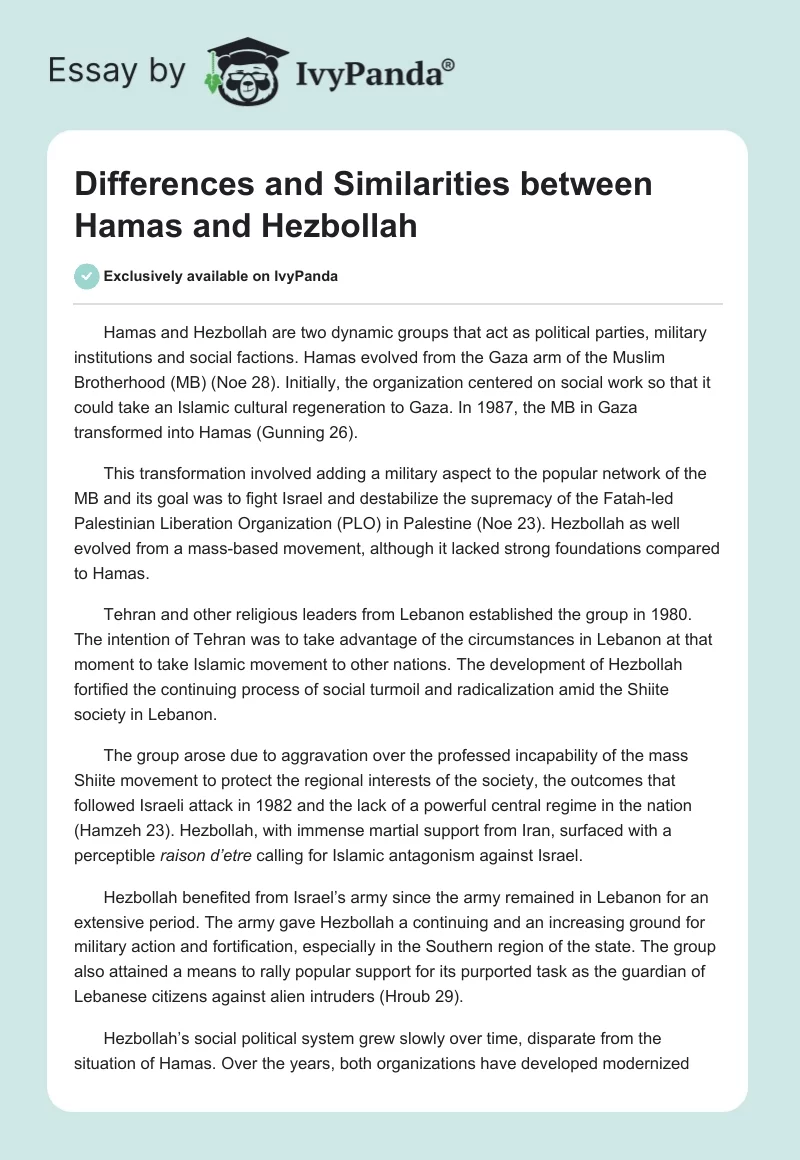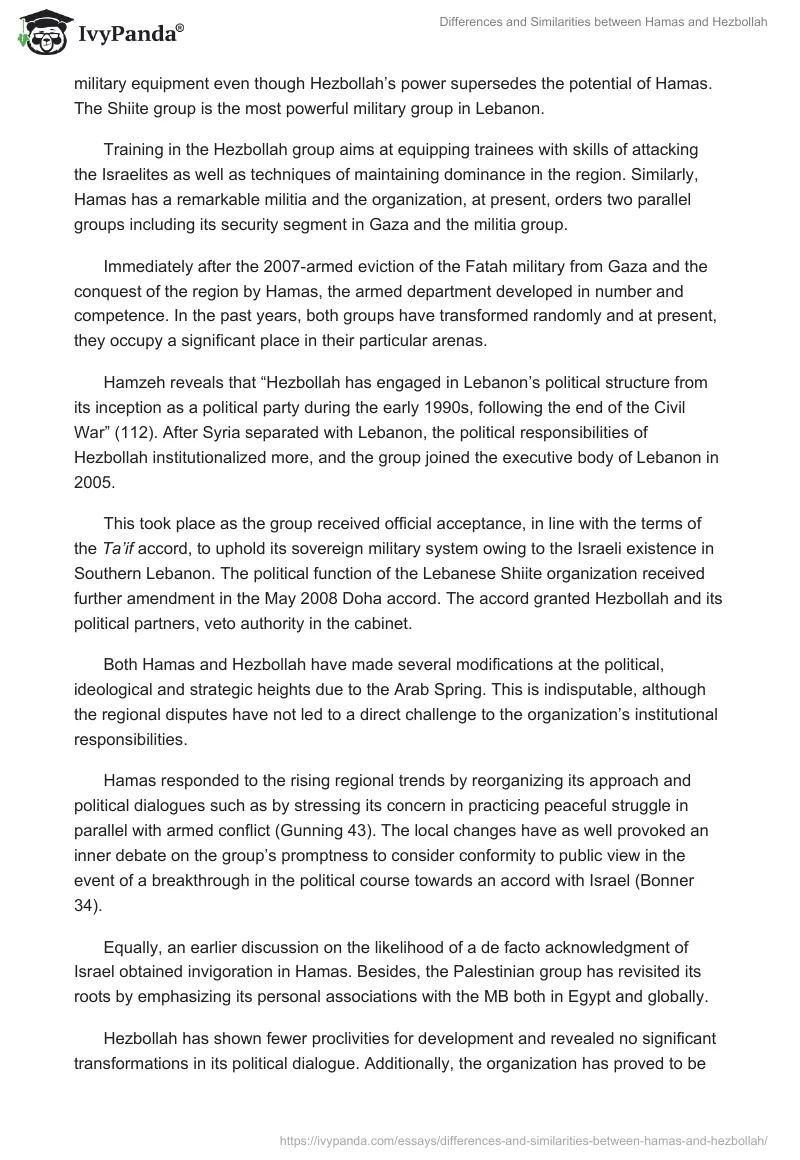Hamas and Hezbollah are two dynamic groups that act as political parties, military institutions and social factions. Hamas evolved from the Gaza arm of the Muslim Brotherhood (MB) (Noe 28). Initially, the organization centered on social work so that it could take an Islamic cultural regeneration to Gaza. In 1987, the MB in Gaza transformed into Hamas (Gunning 26).
This transformation involved adding a military aspect to the popular network of the MB and its goal was to fight Israel and destabilize the supremacy of the Fatah-led Palestinian Liberation Organization (PLO) in Palestine (Noe 23). Hezbollah as well evolved from a mass-based movement, although it lacked strong foundations compared to Hamas.
Tehran and other religious leaders from Lebanon established the group in 1980. The intention of Tehran was to take advantage of the circumstances in Lebanon at that moment to take Islamic movement to other nations. The development of Hezbollah fortified the continuing process of social turmoil and radicalization amid the Shiite society in Lebanon.
The group arose due to aggravation over the professed incapability of the mass Shiite movement to protect the regional interests of the society, the outcomes that followed Israeli attack in 1982 and the lack of a powerful central regime in the nation (Hamzeh 23). Hezbollah, with immense martial support from Iran, surfaced with a perceptible raison d’etre calling for Islamic antagonism against Israel.
Hezbollah benefited from Israel’s army since the army remained in Lebanon for an extensive period. The army gave Hezbollah a continuing and an increasing ground for military action and fortification, especially in the Southern region of the state. The group also attained a means to rally popular support for its purported task as the guardian of Lebanese citizens against alien intruders (Hroub 29).
Hezbollah’s social political system grew slowly over time, disparate from the situation of Hamas. Over the years, both organizations have developed modernized military equipment even though Hezbollah’s power supersedes the potential of Hamas. The Shiite group is the most powerful military group in Lebanon.
Training in the Hezbollah group aims at equipping trainees with skills of attacking the Israelites as well as techniques of maintaining dominance in the region. Similarly, Hamas has a remarkable militia and the organization, at present, orders two parallel groups including its security segment in Gaza and the militia group.
Immediately after the 2007-armed eviction of the Fatah military from Gaza and the conquest of the region by Hamas, the armed department developed in number and competence. In the past years, both groups have transformed randomly and at present, they occupy a significant place in their particular arenas.
Hamzeh reveals that “Hezbollah has engaged in Lebanon’s political structure from its inception as a political party during the early 1990s, following the end of the Civil War” (112). After Syria separated with Lebanon, the political responsibilities of Hezbollah institutionalized more, and the group joined the executive body of Lebanon in 2005.
This took place as the group received official acceptance, in line with the terms of the Ta’if accord, to uphold its sovereign military system owing to the Israeli existence in Southern Lebanon. The political function of the Lebanese Shiite organization received further amendment in the May 2008 Doha accord. The accord granted Hezbollah and its political partners, veto authority in the cabinet.
Both Hamas and Hezbollah have made several modifications at the political, ideological and strategic heights due to the Arab Spring. This is indisputable, although the regional disputes have not led to a direct challenge to the organization’s institutional responsibilities.
Hamas responded to the rising regional trends by reorganizing its approach and political dialogues such as by stressing its concern in practicing peaceful struggle in parallel with armed conflict (Gunning 43). The local changes have as well provoked an inner debate on the group’s promptness to consider conformity to public view in the event of a breakthrough in the political course towards an accord with Israel (Bonner 34).
Equally, an earlier discussion on the likelihood of a de facto acknowledgment of Israel obtained invigoration in Hamas. Besides, the Palestinian group has revisited its roots by emphasizing its personal associations with the MB both in Egypt and globally.
Hezbollah has shown fewer proclivities for development and revealed no significant transformations in its political dialogue. Additionally, the organization has proved to be ideologically incoherent with regard to the Arab initiation. Hezbollah initially took the part of the Arab path and backed the transformations, but later changed positions and supported the Assad rule as well as political resistance in Syria.
Hezbollah’s support of Syria has spurred broad criticism about the group and its insincerity at both local and regional heights. The regional stimulation elevated the topic of Palestinian reconciliation, for Hamas. Hamas, in 2011, feared the possibility of the regional chaos expanding to the Gaza strip, aggravated by the domestic dissatisfaction over the venerable grudge between Hamas and Fatah.
The tough desire, by the two groups, to diffuse a possible exhibition outcome of the Arab Spring on the Palestinian terrains made them settle for the May 2011 reconciliation accord. The Arab Spring’s political effect on Hezbollah is equally noteworthy, because it had a link with “Assad and his Syrian government” (Noe 11). Hezbollah’s support of Assad has led to further corrosion of the already pungent associations with the March 14 lobby group.
Besides, it has steered the political split between the Shiite society and Hezbollah as well as the relationship between Sunni republic and Hezbollah (Noe 16). The Shiite society supports the Assad regime while the Sunni serve as opposition forces. Sometimes, the pressure rises into full planned armed conflicts, causing more internal insecurity and intimidating Hezbollah’s regional position.
Additionally, Hezbollah seems to be losing its political power with regard to its own political associates, mostly differing on the topic of Syria. Tactically, the continuous rise of Syria’s internal crisis has had an effect to both Hamas and Hezbollah. Previously, Syria was a key ally of both organizations. Looking at Hamas, Syria has constantly supported the Palestinian organization, but, at the same time, lodging the head office of the political agency.
Syria acted as the connecting bond between Lebanon and Iran, facilitating the transmission of arms and technical support from Tehran to Hezbollah. In addition, the Assad family supported Hezbollah powerfully, and throughout the extensive years of Syrian support over Lebanon, Damascus sheltered the group and its arms.
Conversely, although both organizations had links to the Assad government, Hamas and Hezbollah responded very diversely to the political complains in Syria. On one side, Hamas maintained a strong political relationship with Assad and religious affiliations to the Sunni mass that condemned the rule dominated by Alawite. Seemingly, backing the Syrian government as Hizbolah and Iran did was not a good option for Hamas.
This elucidates the early disinclination exhibited by Hamas governors to attack the Syrian government and assume the place of the activists. This had transpired in the incidence of Tunisia and Egypt Hamas decided to remain silent on the Syrian crisis. When the crisis soared, Hamas’s principle of non-interference began to change.
The affiliation with both the Assad regime and Iran swiftly became tepid owing to Hamas failure to support the Syrian government. As the crisis continued, Hamas detached itself from Damascus through minimizing its existence in Syria and shifting its political office, discreetly. The strained affiliation between Hamas and Syria has in fact been among the most significant effects of the Arab Spring for the Palestinian body.
It signifies a great opportunity for Hamas to restructure its regional associations and diverge from the centre of resistance directing the group nearer to Egypt and the Gulf states. Hezbollah, on the other hand, cannot separate with Assad. The organization depends on Syria for logistics and has ideological and logistical links with Iran. Its links with Iran enables the organization to have power within the Shiite society and thus in the entire Lebanon.
Actually, Hezbollah does not have any other valuable supporter apart from Syria and Iran. Even its relationship with the opposition groups in Syria is very hostile. Seemingly, these groups would opt to reject Hezbollah after the departure of Assad and their rise to power. Therefore, the threats of Assad’s government and the chaos in Syria have put Hezbollah in an awkward position.
The end of the Syrian government would also change the political game in Lebanon, thus strengthening Hezbollah’s political antagonism, supported by Saudi Arabia. Therefore, both Hezbollah and Hamas have experienced much influence from the Arab Spring at the political, ideological and strategic heights, but the position of Hamas appears more hopeful compared to Hezbollah.
Two rationales are behind this situation. First, the Palestinian assembly has managed to acclimatize to the changing political surrounding despite the difficulties in translating the willingness to reunite with the PA. Second, Hama accepted to reach a settlement with Israel but this is yet to take place. While Hezbollah has strong strategic connections to both Iran and Syria, it has refrained from reacting to the regional changes, swiftly.
In conclusion, Hezbollah and Hamas compare and differ in several ways. Throughout the years, both organizations have developed modernized military equipment even though Hezbollah’s power supersedes the potential of Hamas. Hezbollah as well evolved from a mass-based movement, although it lacked strong foundations compared to Hamas.
Although both organizations had links to the Assad government, Hamas and Hezbollah responded very diversely to the political complains in Syria. Hezbollah does not have any other valuable supporter apart from Syria and Iran. Even its relationship with the opposition groups in Syria is very hostile.
Even its relationship with the opposition groups in Syria is very hostile. These groups would opt to reject Hezbollah after the departure of Assad and their rise to power. Therefore, the threats of Assad’s government and the chaos in Syria have put Hezbollah in an awkward position.
Both Hamas and Hezbollah have made several modifications at the political, ideological and strategic heights due to the Arab Spring. This is indisputable, although the regional disputes have not led to a direct challenge to the organization’s institutional responsibilities.
Works Cited
Bonner, Michael. Jihad in Islamic History: Doctrines and Practices. Princeton: Princeton University Press, 2006. Print.
Gunning, Jeroen. Hamas in Politics: Democracy, Religion, Violence. New York: Columbia University Press, 2008. Print.
Hamzeh, Ahmad Nizar. In the Path of Hizbullah, New York: Syracuse University Press, 2004. Print.
Hroub, Khaled. Hamas: Political Thought and Practice. Washington D.C: Institute for Palestine Studies, 2000. Print.
Noe, Nicolas. Voice of Hezbollah: The Statements of Sayyed Hassan Nasrallah, London: Verso, 2007.Print.


